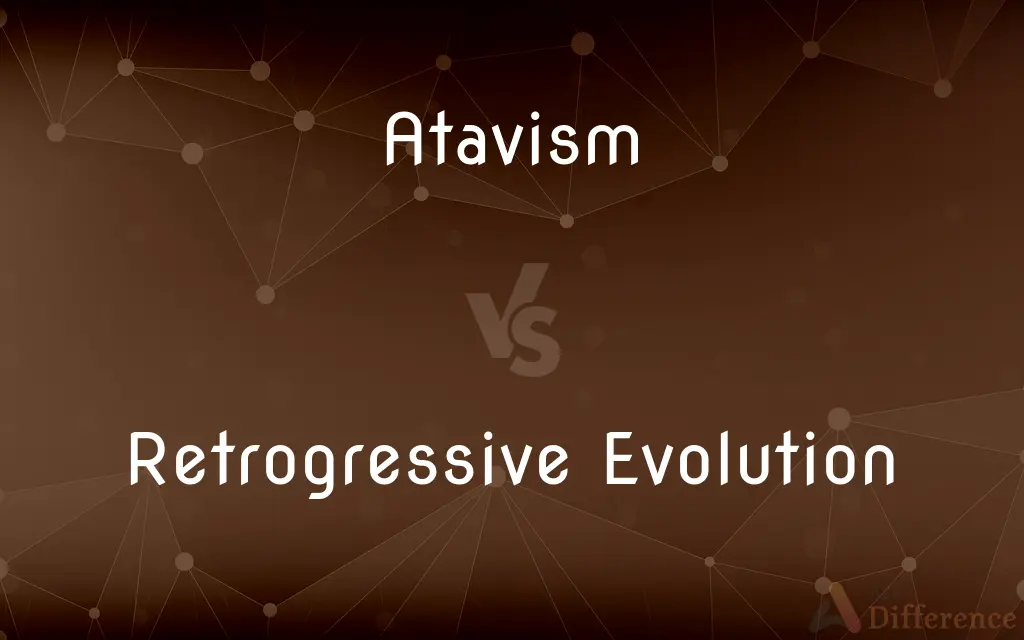Atavism vs. Retrogressive Evolution — What's the Difference?
By Tayyaba Rehman & Urooj Arif — Published on January 30, 2024
Atavism is the reoccurrence of traits from ancestral forms, while retrogressive evolution involves evolutionary changes that simplify or reduce structures.

Difference Between Atavism and Retrogressive Evolution
Table of Contents
ADVERTISEMENT
Key Differences
Atavism refers to the reappearance of ancestral traits in an organism, often due to genetic factors. It can manifest as physical features or behaviors that were common in ancestors but are not typical in modern individuals. For example, humans occasionally being born with a vestigial tail is considered an atavistic trait, reminiscent of our primate ancestors. Retrogressive Evolution, on the other hand, is an evolutionary process where organisms evolve towards a simpler or more primitive state. This can involve the loss or reduction of complex structures or functions that are no longer advantageous in a particular environment. For instance, the loss of eyes in cave-dwelling animals is an example of retrogressive evolution, as sight is not beneficial in an environment without light.
Atavism can occur in any species and is not necessarily indicative of a backward step in evolution. It's more about the unexpected and sporadic reemergence of traits that were thought to be lost in the evolutionary process. Retrogressive Evolution implies a directional change over time across a species or group, often driven by environmental changes or other evolutionary pressures. This evolution is characterized by the loss or simplification of traits rather than their reemergence.
Atavism is not a widespread phenomenon in a species but rather a rare occurrence, often seen as a genetic anomaly. It does not influence the overall evolutionary direction of a species. In contrast, Retrogressive Evolution reflects a more consistent and collective evolutionary trend within a species or group, often observed over many generations.
Atavism does not necessarily provide an advantage or disadvantage to the organism. It's a neutral expression of genetic variability. However, Retrogressive Evolution often results from an adaptation to specific environmental conditions, where certain traits become redundant and are thus lost or reduced. This can provide a survival advantage under those specific conditions.
The study of Atavism helps scientists understand the genetic and developmental processes underlying the expression of ancient traits. It offers insights into the evolutionary history and genetic makeup of species. The study of Retrogressive Evolution provides understanding into how organisms adapt to changing environments and the evolutionary processes that lead to the simplification of structures and functions.
ADVERTISEMENT
Comparison Chart
Definition
Reappearance of ancestral traits
Evolution towards simpler forms
Occurrence
Rare and sporadic
Consistent and directional
Evolutionary Implication
Neutral, does not direct species evolution
Reflects adaptation to environment
Influence on Organism
Neutral, can be advantageous or not
Often advantageous in specific environments
Study Significance
Reveals genetic and evolutionary history
Shows adaptation and simplification processes
Compare with Definitions
Atavism
Atavism is the unexpected expression of ancestral characteristics.
The presence of dense body hair in a human is an atavism, linking back to fur-covered ancestors.
Retrogressive Evolution
Retrogressive Evolution signifies evolutionary adaptations towards simplicity.
The reduction of the digestive system in parasites is retrogressive evolution, adapting to a symbiotic lifestyle.
Atavism
Atavism refers to the sporadic reemergence of a lost evolutionary trait.
A human born with webbed fingers exhibits atavism, reflecting an aquatic phase in human evolution.
Retrogressive Evolution
Retrogressive Evolution involves simplifying or reducing biological structures.
The degeneration of wings in some island birds exemplifies retrogressive evolution due to the lack of predators.
Atavism
Atavism is a rare genetic phenomenon revealing ancient lineage traits.
The emergence of a vestigial tail in humans is an atavism, showing a connection to tailed ancestors.
Retrogressive Evolution
Retrogressive Evolution is the evolutionary process of losing complex traits.
The loss of eyes in cave fish is an instance of retrogressive evolution, adapting to a dark environment.
Atavism
The reappearance of a characteristic in an organism after several generations of absence.
Retrogressive Evolution
Retrogressive Evolution occurs when organisms evolve to lose redundant features.
The shrinking of the olfactory lobes in primates is retrogressive evolution, due to the reduced reliance on smell.
Atavism
An individual or a part that exhibits atavism. Also called throwback.
Retrogressive Evolution
Retrogressive Evolution is a backward evolutionary trend resulting in simpler forms.
The loss of pigmentation in subterranean animals is a case of retrogressive evolution, unnecessary in the absence of sunlight.
Atavism
The return of a trait or recurrence of previous behavior after a period of absence.
Atavism
The reappearance of an ancestral characteristic in an organism after several generations of absence; a throwback.
Atavism
The recurrence or reversion to a past behaviour, method, characteristic or style after a long period of absence.
Atavism
(sociology) Reversion to past primitive behavior, especially violence.
Atavism
The recurrence, or a tendency to a recurrence, of the original type of a species in the progeny of its varieties; resemblance to remote rather than to near ancestors; reversion to the original form.
Now and then there occur cases of what physiologists call atavism, or reversion to an ancestral type of character.
Atavism
Recurrence of or reversion to a past style, outlook, approach, or manner.
Atavism
A reappearance of an earlier characteristic
Atavism
Atavism is the recurrence of traits from an ancestor in a modern organism.
The appearance of a tail in a human newborn is an example of atavism, harking back to our primate ancestry.
Atavism
Atavism represents a genetic throwback, often visible in physical features.
Extra toes in a cat are an atavism, reminiscent of their wild ancestors.
Common Curiosities
Is atavism common in humans?
Atavism is rare in humans, with occurrences like vestigial tails being exceptional.
Does atavism affect the evolutionary process?
Atavism does not significantly affect the evolutionary trajectory of a species; it's more a reflection of genetic diversity.
What causes atavism?
Atavism is caused by genetic factors, where dormant genes from ancestors get expressed in modern individuals.
What is atavism?
Atavism is the reappearance of an ancestral trait in a modern organism, often seen as a genetic anomaly.
Does retrogressive evolution happen in all species?
Retrogressive evolution can occur in any species, but it is not universal and depends on specific evolutionary pressures.
Can atavism be predicted?
Atavism is generally unpredictable, as it results from rare genetic expressions.
Can atavism be beneficial?
While atavism is usually neutral, certain atavistic traits can provide unforeseen advantages in specific environments.
What is retrogressive evolution?
Retrogressive evolution is the evolutionary process where organisms evolve towards simpler or more primitive forms.
Is retrogressive evolution a sign of de-evolution?
Retrogressive evolution is not de-evolution but an adaptation process where certain traits are lost or reduced as they become redundant.
Are atavistic traits hereditary?
Atavistic traits can be passed down genetically, but their sporadic nature makes them unpredictable.
What drives retrogressive evolution?
Retrogressive evolution is often driven by environmental changes, making certain complex traits unnecessary or disadvantageous.
Can retrogressive evolution happen quickly?
The speed of retrogressive evolution varies, depending on environmental pressures and the organism's adaptability.
How is retrogressive evolution studied?
Retrogressive evolution is studied through comparative anatomy, genetics, and observation of species in changing environments.
Are there human examples of retrogressive evolution?
In humans, the reduction of body hair and the appendix are examples of retrogressive evolution.
Can retrogressive evolution be reversed?
In theory, retrogressive evolution could be reversed if environmental conditions change, making lost traits advantageous again. However, this is a complex and lengthy process.
Share Your Discovery

Previous Comparison
AKA vs. Delta
Next Comparison
Checked Exception in Java vs. Unchecked Exception in JavaAuthor Spotlight
Written by
Tayyaba RehmanTayyaba Rehman is a distinguished writer, currently serving as a primary contributor to askdifference.com. As a researcher in semantics and etymology, Tayyaba's passion for the complexity of languages and their distinctions has found a perfect home on the platform. Tayyaba delves into the intricacies of language, distinguishing between commonly confused words and phrases, thereby providing clarity for readers worldwide.
Co-written by
Urooj ArifUrooj is a skilled content writer at Ask Difference, known for her exceptional ability to simplify complex topics into engaging and informative content. With a passion for research and a flair for clear, concise writing, she consistently delivers articles that resonate with our diverse audience.
















































